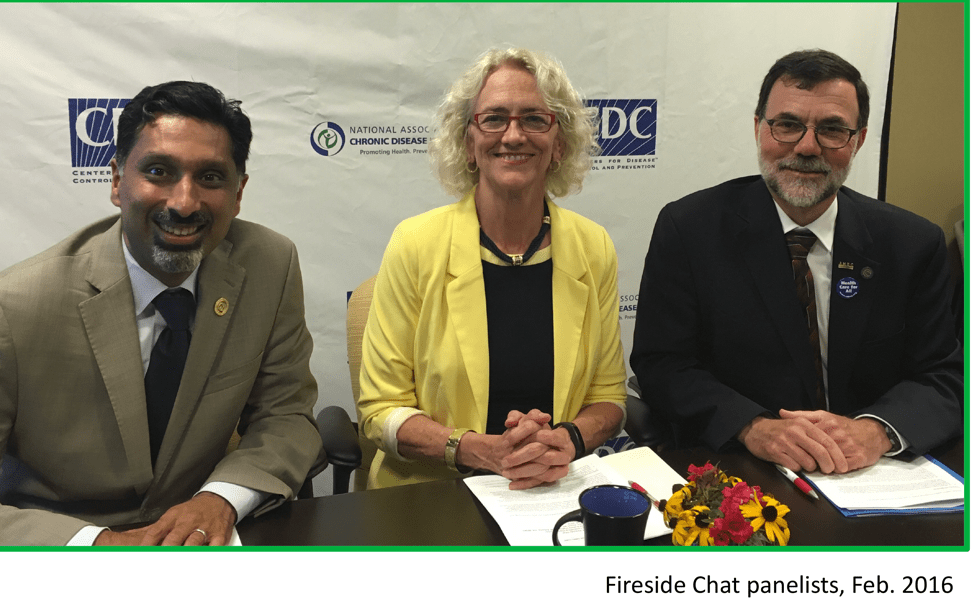CARDIOVASCULAR HEALTH
Cardiovascular Health Resources
Issue Briefs and Reports
Webinars, Fireside Chats,
and Virtual Roundtables


NACDD and CDC: Under Pressure: Black Men and the Battle of Hypertension
Best practices, treatments, and approaches for reaching Black men and treating hypertension.
- Written Summary: Under Pressure: Black Men and the Battle of Hypertension
- Speaker Bios
Guidelines for the Prevention, Detection, Evaluation, and Management of High Blood Pressure in Adults
Data Driven Systems Change and Improvement in Hypertension Control
Health systems changes implemented through a partnership between the Massachusetts Department of Public Health the Massachusetts League of Community Health Centers.
- Issue Brief: Data-Driven Systems Change and Improvement in Hypertension
- Audio Recording
- Presenter Slides
- QI Assessment Model Report
- DRVS 1422 Measures
Addressing Health Disparities in Hypertension Control
Overview of the South Carolina Department of Health and Environmental Control (DHEC) and the Care Coordination Institute (CCI). DHEC has made health disparities a priority in its work to improve the lives of South Carolinians.
- Issue brief: Addressing Hypertension Disparities in Hypertension Control
- Description and Speaker Bios
- Video Recording
- Cultural Competency Presentation
Undiagnosed Hypertension
Supporting the Million Hearts focus of identifying people with undiagnosed – and therefore untreated – hypertension.
- Issue brief: Undiagnosed Hypertension
- Summary of virtual roundtables on Identifying Patients with Undiagnosed Hypertension
Coverage and Reimbursement Analysis
CDC and NACDD commissioned the Department of Health Policy and Management at the George Washington University Milken Institute School of Public Health to develop A National Analysis of Self Measured Blood Pressure Monitoring report to support efforts to scale and spread the use of SMBP. Resources can be found here.
NACDD and CDC: Y-USA Blood Pressure Self-Monitoring Program
The Y-USA Blood Pressure Self-Monitoring Program was designed this program to help adults with hypertension lower and manage their blood pressure. Visit here for more information.
Team-Based Approaches to Control Hypertension
NACDD and the CDC’s Division for Heart Disease and Stroke Prevention hosted a fireside chat and follow-up virtual roundtables to address team-based approaches to controlling hypertension.
- Issue brief and virtual roundtable summary on Team-Based Approach to Controlling Hypertension
- Description and Speaker Bios
- Video Recording
- Issue Brief
CHW Common Indicators Project
The purpose of the CHW Common Indicators Project is to contribute to the integrity, sustainability and viability of CHW programs through the collaborative development and adoption of a set of common process and outcome constructs and indicators.
- Policy Brief: CHW-Driven Measurement to Sustain the Profession
- Proposed Indicators for Priority Constructs
Document Resource Center
The NACHW Document Resource Center (DRC) is the nation’s largest collection of searchable CHW policy focused documents, many of which have been systematically reviewed based on topic and quality.
The following translation reports were developed using resources found within the DRC. They highlight the ways in which one might use the DRC to support policy development:
In coordination with CDC’s Division for Heart Disease and Stroke Prevention, NACDD implemented two Pharmacy Related Resource collaboratives, bringing together state teams of public health and pharmacy partners to accelerate team-based care to manage high blood pressure and high cholesterol.
Advancing Pharmacy-Related Interventions to Control Hypertension and Manage Cholesterol Learning Collaborative
Final Report: 2020 Advancing Pharmacy-Related Interventions to Control Hypertension and Manage Cholesterol Learning Collaborative
Adapting to the “New Normal”: Expanding Telehealth Services Through Public Health Collaboration with USC Virtual Pharmacist
Advancing Team-Based Care Through the Use of Collaborative Practice Agreements and Using the Pharmacists’ Patient Care Process to Manage High Blood Pressure
Community e-Connect: How to Achieve Successful Bi-Directional Referrals for Diabetes, Hypertension, and High Cholesterol
Community e-Connect is a bi-directional linkage between clinical electronic health records (EHRs) and community-based organizations (CBOs). Using this system, health sites in Massachusetts were able to show a sustained decrease in systolic blood pressure of 3.0 mm Hg for patients who received services in community settings compared to a matched sample of patients whose blood pressure was “out of control.”
NACDD assists State Health Departments in promoting successful programs to improve the health of communities and to reduce the burden of chronic disease across the U.S. through development of success stories. Submit a success story to the What’s Working in Chronic Disease Prevention and Control Database here.
